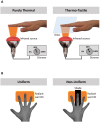Thermal referral: evidence for a thermoceptive uniformity illusion without touch
- PMID: 27775034
- PMCID: PMC5075768
- DOI: 10.1038/srep35286
Thermal referral: evidence for a thermoceptive uniformity illusion without touch
Abstract
When warm thermal stimulators are placed on the ring and index fingers of one hand, and a neutral-temperature stimulator on the middle finger, all three fingers feel warm. This illusion is known as thermal referral (TR). On one interpretation, the heterogenous thermal signals are overridden by homogenous tactile signals. This cross-modal thermo-tactile interaction could reflect a process of object recognition, based on the prior that many objects are thermally homogenous. Interestingly, the illusion was reported to disappear when the middle digit was lifted off the thermal stimulator, suggesting that tactile stimulation is necessary. However, no study has investigated whether purely thermal stimulation might induce TR, without any tactile object to which temperature can be attributed. We used radiant thermal stimulation to deliver purely thermal stimuli, which either were or were not accompanied by simultaneous touch. We found identical TR effects in both the original thermo-tactile condition, and in a purely thermoceptive condition where no tactile object was present. Control experiments ruled out explanations based on poor spatial discrimination of warm signals. Our purely thermoceptive results suggest that TR could reflect low-level organization of the thermoceptive pathway, rather than a cognitive intermodal modulation based on tactile object perception.
Figures





Similar articles
-
Thermal-Tactile Integration in Object Temperature Perception.IEEE Trans Haptics. 2019 Oct-Dec;12(4):594-603. doi: 10.1109/TOH.2019.2894153. Epub 2019 Feb 26. IEEE Trans Haptics. 2019. PMID: 30835230
-
Cooling the thermal grill illusion through self-touch.Curr Biol. 2010 Oct 26;20(20):1819-22. doi: 10.1016/j.cub.2010.08.038. Epub 2010 Sep 30. Curr Biol. 2010. PMID: 20869246
-
Somatotopic or spatiotopic? Frame of reference for localizing thermal sensations under thermo-tactile interactions.Atten Percept Psychophys. 2010 Aug;72(6):1666-75. doi: 10.3758/APP.72.6.1666. Atten Percept Psychophys. 2010. PMID: 20675809
-
The interaction between motion and texture in the sense of touch.J Neurophysiol. 2021 Oct 1;126(4):1375-1390. doi: 10.1152/jn.00583.2020. Epub 2021 Sep 8. J Neurophysiol. 2021. PMID: 34495782 Review.
-
Somesthetic senses.Annu Rev Psychol. 2010;61:243-71. doi: 10.1146/annurev.psych.093008.100419. Annu Rev Psychol. 2010. PMID: 19575612 Review.
Cited by
-
Revisiting a classical theory of sensory specificity: assessing consistency and stability of thermosensitive spots.J Neurophysiol. 2023 Dec 1;130(6):1567-1577. doi: 10.1152/jn.00275.2023. Epub 2023 Nov 15. J Neurophysiol. 2023. PMID: 37964756 Free PMC article.
-
Thermal illusions for thermal displays: a review.Front Hum Neurosci. 2023 Dec 5;17:1278894. doi: 10.3389/fnhum.2023.1278894. eCollection 2023. Front Hum Neurosci. 2023. PMID: 38116235 Free PMC article. Review.
-
Thermonociceptive interaction: interchannel pain modulation occurs before intrachannel convergence of warmth.J Neurophysiol. 2019 May 1;121(5):1798-1808. doi: 10.1152/jn.00341.2018. Epub 2019 Mar 13. J Neurophysiol. 2019. PMID: 30864857 Free PMC article.
References
-
- Craig A. D., Chen K., Bandy D. & Reiman E. M. Thermosensory activation of insular cortex. Nature Neurosci. 3, 184–190 (2000). - PubMed
-
- Weber E. H. On the sensitivity of the tactile senses In E. H. Weber on the tactile senses (eds and trans Ross H. E. & Murray D. J.) 21–136 (Taylor & Francis, 1996).
-
- Green B. G. Localization of thermal sensation: An illusion and synthetic heat. Percept Psychophys. 22, 331–337 (1977).
Publication types
MeSH terms
LinkOut - more resources
Full Text Sources
Other Literature Sources

